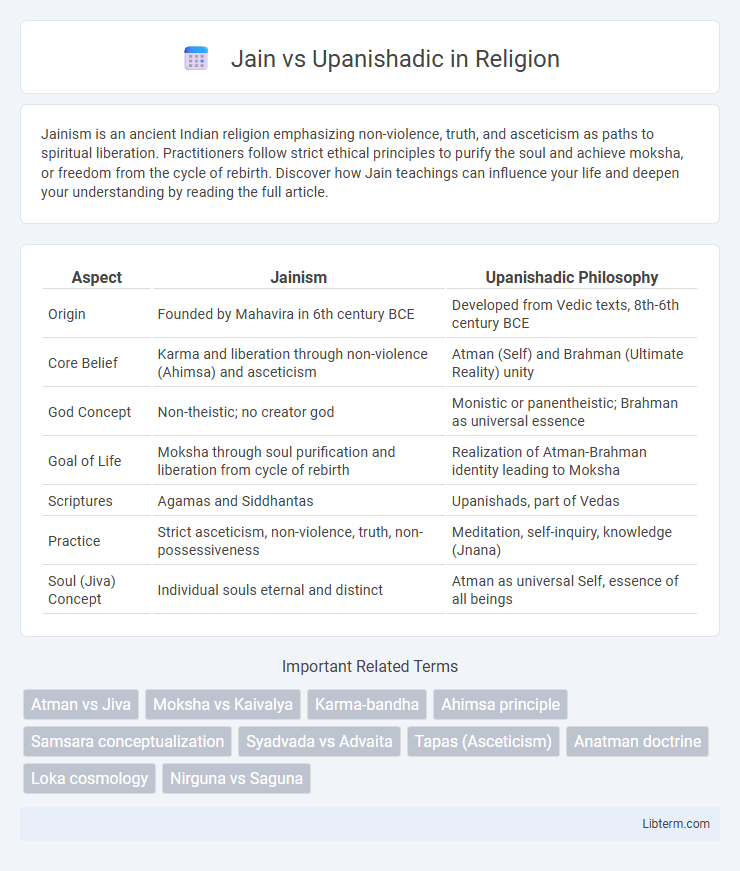Jainism is an ancient Indian religion emphasizing non-violence, truth, and asceticism as paths to spiritual liberation. Practitioners follow strict ethical principles to purify the soul and achieve moksha, or freedom from the cycle of rebirth. Discover how Jain teachings can influence your life and deepen your understanding by reading the full article.
Table of Comparison
| Aspect | Jainism | Upanishadic Philosophy |
|---|---|---|
| Origin | Founded by Mahavira in 6th century BCE | Developed from Vedic texts, 8th-6th century BCE |
| Core Belief | Karma and liberation through non-violence (Ahimsa) and asceticism | Atman (Self) and Brahman (Ultimate Reality) unity |
| God Concept | Non-theistic; no creator god | Monistic or panentheistic; Brahman as universal essence |
| Goal of Life | Moksha through soul purification and liberation from cycle of rebirth | Realization of Atman-Brahman identity leading to Moksha |
| Scriptures | Agamas and Siddhantas | Upanishads, part of Vedas |
| Practice | Strict asceticism, non-violence, truth, non-possessiveness | Meditation, self-inquiry, knowledge (Jnana) |
| Soul (Jiva) Concept | Individual souls eternal and distinct | Atman as universal Self, essence of all beings |
Introduction to Jainism and Upanishadic Philosophy
Jainism, established by Mahavira in the 6th century BCE, emphasizes non-violence (ahimsa), self-discipline, and liberation through strict ethical conduct and asceticism. Upanishadic philosophy, forming the spiritual core of Hinduism, explores metaphysical questions about Brahman (ultimate reality) and Atman (self), advocating knowledge (jnana) and meditation as paths to moksha (liberation). While Jainism focuses on individual soul purification and karma cessation, Upanishadic teachings highlight the unity of the individual soul with the ultimate cosmic principle.
Historical Origins and Development
Jainism emerged around the 6th century BCE with teachings attributed to Mahavira, emphasizing non-violence (ahimsa) and liberation through strict ethical discipline. The Upanishads, composed between 800 and 400 BCE, represent the philosophical culmination of Vedic traditions, focusing on concepts like Brahman (ultimate reality) and Atman (self). Jainism developed independently from Vedic rituals, while Upanishadic thought evolved within the broader Indo-Aryan spiritual context, influencing Hindu philosophy significantly.
Core Philosophical Beliefs
Jain philosophy centers on the principles of non-violence (ahimsa), non-possessiveness (aparigraha), and the liberation of the soul through strict ethical discipline and self-purification, emphasizing karma as a physical substance influencing rebirth. Upanishadic philosophy explores the concept of Brahman (ultimate reality) and Atman (inner self), highlighting knowledge (jnana) and meditation as paths to realize the unity of individual soul and universal consciousness. Both traditions value liberation (moksha), yet Jainism stresses individual effort and strict asceticism, while the Upanishads focus on metaphysical knowledge and inner realization.
Concept of Self and Soul (Atman vs Jiva)
Jain philosophy defines the self (Jiva) as an eternal, individual soul characterized by consciousness and moral responsibility, distinct from matter and capable of liberation through strict ethical conduct and non-attachment. In contrast, Upanishadic thought presents Atman as the universal, unchanging essence of self that is identical with Brahman, emphasizing inner realization and transcendence of ego to attain moksha. While Jiva maintains individuality in multiple souls, Atman in the Upanishads underscores the unity of all existence within a singular, supreme reality.
Metaphysics: Reality and Ultimate Truth
Jain metaphysics asserts a pluralistic reality where substances such as soul (jiva) and matter (ajiva) coexist eternally, emphasizing individual souls achieving liberation through karmic purification. In contrast, Upanishadic metaphysics centers on the unity of Atman (self) and Brahman (ultimate reality), highlighting non-dualism and the realization of oneness as the path to truth. Jainism's dualistic framework contrasts with the monistic idealism of the Upanishads, reflecting distinct approaches to ultimate truth and cosmic substance.
Ethical Principles and Practices
Jain ethics emphasize non-violence (ahimsa), truthfulness (satya), non-stealing (asteya), celibacy (brahmacharya), and non-possessiveness (aparigraha), promoting strict self-discipline and asceticism as paths to liberation. Upanishadic teachings focus on inner knowledge, unity of the self (Atman) with ultimate reality (Brahman), and ethical virtues such as truth, self-control, and detachment, guiding seekers towards spiritual realization and enlightenment. While both stress ethical living and non-attachment, Jainism adopts a more rigorous ascetic practice, whereas Upanishadic philosophy integrates meditation and introspection to transcend worldly suffering.
Liberation and Moksha: Jain and Upanishadic Perspectives
Jain philosophy defines liberation (moksha) as the soul's complete release from karma and rebirth through strict ethical conduct, non-violence (ahimsa), and self-discipline, emphasizing individual effort and asceticism. In contrast, Upanishadic teachings view moksha as the realization of the soul's unity with Brahman, achieved through knowledge (jnana), meditation, and detachment from material existence. Both traditions prioritize liberation but differ fundamentally in paths and metaphysical interpretations of the soul and ultimate reality.
Rituals and Religious Practices
Jainism emphasizes strict non-violence (ahimsa) and ascetic rituals, including fasting, meditation, and the renunciation of worldly possessions, as essential for spiritual liberation. Upanishadic traditions primarily focus on rituals like yajnas (sacrificial ceremonies) and meditation practices aimed at realizing the Atman and attaining moksha through knowledge (jnana). While Jain rituals center on self-discipline and ethical conduct, Upanishadic practices integrate metaphysical teachings with Vedic ritualism for spiritual enlightenment.
Influence on Indian Society and Culture
Jain philosophy's emphasis on non-violence (ahimsa) and asceticism profoundly shaped Indian ethical practices and inspired movements for animal rights and environmental conservation. Upanishadic thought introduced the concept of Brahman and Atman, deeply influencing Indian spirituality, meditation, and the pursuit of self-realization across diverse religious traditions. Both traditions enriched Indian art, literature, and social values, promoting introspection and moral discipline as core cultural ideals.
Comparative Analysis: Similarities and Differences
Jain and Upanishadic philosophies both emphasize non-violence, self-realization, and liberation from the cycle of birth and death, although they differ in metaphysical concepts and practices. Jainism strictly advocates ahimsa and asceticism as means to purify the soul, while Upanishads explore knowledge (jnana) and meditation as paths to realize the universal Brahman. The Upanishadic worldview is rooted in monism with a focus on Atman-Brahman unity, whereas Jainism promotes a pluralistic universe with independent souls (jivas) each possessing intrinsic qualities.
Jain Infographic

 libterm.com
libterm.com